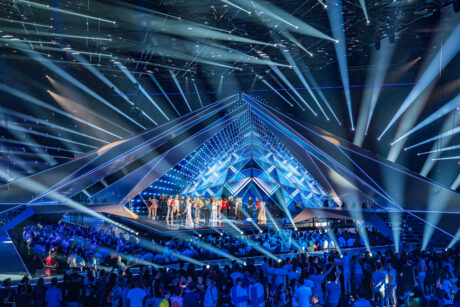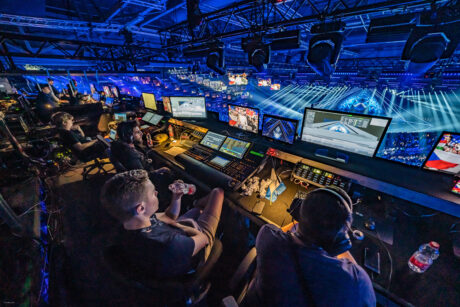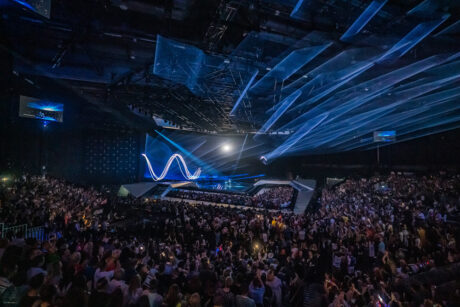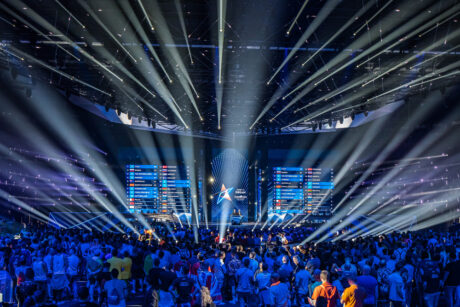
TEL AVIV, Israel — If the big production design news at Eurovision 2018 in Portugal was a stark shift away from video overload and back to moving beams of light, the visual pendulum has swung back to video in 2019 (although this year’s lighting effects were hugely impressive as well.)
Staged with a “Dare to Dream” theme, the 64th edition of the song contest started out with more than 40 countries, then featured participants from 26 of them at Expo Tel Aviv for the semi-finals (May 14 and 16) and the finals competition (May 18), with some 200 million watching from Europe and around the world as singer/songwriter Duncan Laurence from The Netherlands won.
As noted, video returned to the core of the show, powered by a chorus of disguise vx 4 and 4x4pro servers. The staging design featured 250 square meters of high-res LED, diamond-shaped stage, backed by a 36 12m high-resolution LED wall made up of 12 individual screens, all supplied by PRG. More than 16,998,976 pixels lit up the stage, making it the highest resolution LED set in Eurovision history.

More details from disguise (www.disguise.one):
Eurovision production manager Ola Melzig, and head of video and stage technology Shay Bonder approached disguise to deliver and manage a server system capable of processing the mammoth amount of data required for the vast scale of the project.
“With more than 50 live acts performing in quick succession with various tech props including huge screen projectors and massive amounts of LED, we needed a powerful system that offered multi-station editing capabilities,” said Bonder.

“A major challenge for us was making the pre-programming process as accurate as possible and then operating it in perfect sync, without issue. disguise’s software allowed us to pre-program with cameras and automation — the camera directors actually showed the camera operators the render from the Designer machines in order to give them instructions, and the ability to program one track while another is playing, plus the power to easily feed content to DMX screens and quick calibration of projectors,” he added. “The disguise system became an integral part of the creative process as we could test video content automation and camera angles in the pre-programming process and change them accordingly to achieve our vision.”

Peter Kirkup, disguise technical solutions manager, worked with Shay Bonder to support him in the system design process. The team specified six disguise vx 4 servers and two 4x4pro servers. “The pro range of disguise servers were designed to play huge video content across massive canvases,” said Kirkup. “Thanks to the VFC technology, the vx 4 and 4x4pro servers allow us to drive large shows like this with fewer machines, reducing space, time, setup, risk, and management overhead.”
The vx 4 servers were used as Pure Master, output slaves and Backup servers. The 4x4pro servers were used for add-on elements and backup. The vx 4s were fully loaded with HDMI 2.0 VFC cards; the 4x4pros had on-board Quad-DVI VFC cards. disguise recently launched its vx 4 servers with more storage and a new NVMe RAID drive array.

“This system design is all about making sure that the performance headroom is enough for the project,” said Jamie Sunter, support specialist at disguise. “With high resolution outputs, large number of props for all the different acts, as well as 400+ universes of Art-Net being output, the system coped fantastically with these requirements. A huge bonus was the larger storage space in the vx 4, meaning the team didn’t have to clean up older file versions during rehearsals.”
The disguise servers received LTC, ensuring the main cues were triggered at the correct time. Much of the programming was completed in the runup to the Tel Aviv events, using disguise’s r15.3 software to pre-visualize the whole show and sequence all the content. The team used disguise’s Visualizer Camera feature and then virtually mapped and sequenced each camera shot and path to the directors’ requirements. From there, they transferred the project from the Designer machines to the actual hardware.
“This was very powerful, as this was the first time that the camera directors could see how all their shots would look for each song, and then send renders to the delegates by simply recording the stage,” Bonder explained. “We had a full 3D model of the stage, as well as seating banks, so that it was a true representation. We also had all the country-specific props and screen movements so it looked exactly how it would for real. From there, the guys then used the OSC module in disguise to send out the camera positions to WYSIWYG. This meant that the Lighting Team also had these Camera pre-visualizations and could see how their design worked with all elements.”
On disguise programming and operating duties was Gwilym Huws, workflow specialist at Bild Studios: “disguise’s feature-set made many elements of pre- and on-site production much simpler and more powerful. It was particularly useful for swapping out props when needed, as well as Screen Position Layer, for the mapping to be correct. Even generative things like radar and strobe were used for some animations in the show on the legs and catwalk.”
“Video content, LED on a massive scale, and projection mapping is the backbone of the Eurovision spectacle, and I was thrilled to bring it back in such an incredible way this year,” concluded Ola Melzig. “This is the first time we’ve brought in disguise’s vx 4 and 4x4pro servers and their support team, including Jamie Sunter, and we’re hugely impressed. With so much to integrate, process and create, the machines and the people did a fantastic job.”
From commission to delivery, disguise’s support team was involved in all aspects of the video project. “Their support was amazing throughout,” said Bonder. “Before the setup in the venue, disguise set us an online Slack account, on which they answered any questions we had from venue setup. On-site, Jamie checked system stability throughout the process and helped us with whatever we needed.”
A hugely talented team worked on delivery of the incredible Eurovision visuals, including Yahav Tenne (Shay Bonder Ltd) – Programmer/Video and Stage Technology Deputy; Gwilym Huws (Bild) – Programmer and Operator/ Consultant; Oren Gabay (Shay Bonder Ltd) – Operator for Shows; Matthias Reuhl (bright! Studios, for PRG) – disguise System Tech; Shay Bonder – Head of Video and Stage Technologies; Jamie Sunter (disguise) – Onsite Support Specialist; Avital Friedman – Video and Stage Tech Dept Manager; Jonathan Frixo and Zohar Levi – Integration Programmers; Danit Daniel – Video and Stage Technology Coordinator. The video content was made by Gravity.
26 countries battled it out in the final to be crowned the winner of Eurovision 2019, with The Netherlands victorious. The live final was broadcast to 200 million viewers in Europe and around the world.


